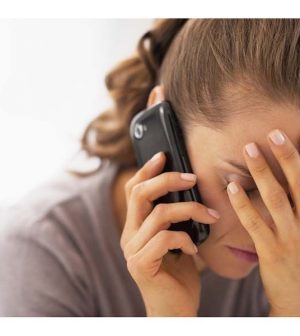- Navigating Your Midlife Crisis: Embracing New Possibilities
- City Raccoons Showing Signs of Domestication
- Mapping the Exposome: Science Broadens Focus to Environmental Disease Triggers
- One Week Less on Social Media Linked to Better Mental Health
- Your Brain Changes in Stages as You Age, Study Finds
- Some Suicide Victims Show No Typical Warning Signs, Study Finds
- ByHeart Formula Faces Lawsuits After Babies Sickened With Botulism
- Switch to Vegan Diet Could Cut Your Greenhouse Gas Emissions in Half
- Regular Bedtime Does Wonders for Blood Pressure
- Dining Alone Could Mean Worse Nutrition for Seniors
The 988 Mental Health Hotline Is Coming. Is America Ready?

The mental health equivalent of 911 is about to launch across the United States, but a new study finds that many communities may not be prepared for it.
Beginning July 16, a new 988 number will be available 24/7 for Americans dealing with a mental health crisis. It’s akin to 911, long used to get help for medical emergencies.
The new code will replace the 10-digit number currently used to reach the National Suicide Prevention Lifeline, which was established in 2005. Health officials expect the easy-to-remember 988 to spur a surge in calls.
The trouble is, few jurisdictions are ready for that, according to the new study, by the nonprofit research organization RAND Corp.
“At the service level, the 988 transition is a simple number change,” said Ryan McBain, a RAND policy researcher who co-led the study.
But on the ground, McBain said, it’s a different story.
For one, local crisis centers need enough counselors to handle any influx of calls. Beyond that, some callers will need additional in-person help.
Yet, the study found, many jurisdictions lack such resources. It surveyed 180 state, regional and county health officials, and found that only half said their jurisdiction had short-term “crisis stabilization” services to which callers could be directed.
Even fewer — 28% — had urgent care units that could be dispatched to people in urgent need. Meanwhile, only 22% had call centers that could schedule mental health appointments on behalf of people who wanted them.
On top of those shortfalls, most local hotlines did not offer text or online chat options. That’s a key gap, McBain said, since teenagers and young adults often prefer those modes of communication.
Overall, McBain said, the findings confirm the concerns of many mental health experts: Jurisdictions have not had the time or resources to prepare for the 988 rollout.
The 988 code was authorized by Congress in 2020, with the intent of giving Americans an easier way to reach the National Suicide Prevention Lifeline. The Lifeline is a network of almost 200 crisis centers throughout the United States. When people call the national number, they are connected with the center closest to them to speak with a trained counselor and, if needed, get help finding local resources.
The intent of the Lifeline, and 988, goes beyond suicide prevention, McBain noted. It offers help to people in mental health distress, including problems related to substance abuse.
Studies have shown that the existing Lifeline network helps most people who call.
“For many callers, the issue will be resolved just by having that contact with a counselor,” said Dr. Robert Trestman, chair of the American Psychiatric Association’s Council on Healthcare Systems and Financing.
“It’s when it comes to referral to local services that things will get more complicated,” said Trestman, who was not involved in the study.
And that issue is nothing new. The new findings, Trestman said, merely highlight the nation’s under-resourced, fragmented mental health care system.
The 988 designation, he noted, came amid a pandemic that has only worsened the situation — taking a huge toll on Americans’ mental health and straining existing mental health services.
Trestman put it bluntly: “We have a mental health care system that was designed to fail.”
The looming 988 launch is only the beginning of efforts to shore up that system, said Dr. John Palmieri, acting director of the 988 coordination office at the U.S. Substance Abuse and Mental Health Services Administration (SAMHSA).
“The Biden/Harris Administration has made significant strides in strengthening and expanding the existing Lifeline, and we expect 988 will continue to grow and evolve in the coming months, as more states start to step up,” Palmieri said in a statement.
He added that the Lifeline network “has been massively underfunded and under-resourced since it began in 2005.”
The Biden Administration has invested $282 million in the 988 transition — but, Palmieri added, states also need to “rev up investments.”
Despite the challenges, all agreed that Americans should use 988 when it becomes available. (According to SAMHSA, if a caller’s local crisis center is unable to answer, the caller will be automatically routed to a national “backup” center.)
“Already, the Lifeline is an incredible service,” McBain said. “Studies show that.”
Trestman agreed, saying that the 988 transition “will go through growing pains,” but it is ultimately a “good thing.”
It’s part of a broad effort, Trestman added, to lift the stigma around mental health care.
Still, McBain said, there is a long way to go before the system is the equivalent of 911 — where callers know, wherever they live, there will be local services available for their physical health emergency.
“To not have an equivalent for mental health is inexcusable,” McBain said.
More information
The Substance Abuse and Mental Health Services Administration has more on 988.
SOURCES: Ryan McBain, PhD, MPH, policy researcher, RAND Corp., Santa Monica, Calif.; John Palmieri, MD, MHA, acting director, 988 and Behavioral Health Crisis Coordination Office, Substance Abuse and Mental Health Services Administration, Rockville, Md.; Robert Trestman, MD, PhD, chair, Council on Healthcare Systems and Financing, American Psychiatric Association, Washington, D.C.; RAND Corp. working paper, June 2022
Source: HealthDay
Copyright © 2025 HealthDay. All rights reserved.










